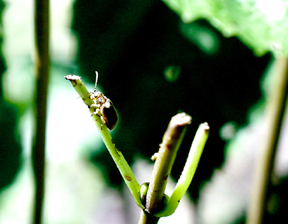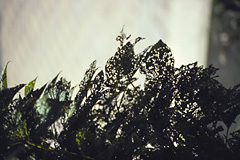Ravenous viburnum leaf beetles emerge in central, western New York and close to northern Pennsylvania border
By Blaine Friedlander

The larvae of the viburnum leaf beetle -- a ravenous pest that feasts on cultivated and native viburnum shrubs, reducing them to skeletal remains -- emerged during early May in western and central New York state, Cornell University entomologists say.
And in late May the beetle was found for the first time in Owego, N.Y., just a few miles from the northern Pennsylvania border.
Homeowners in these areas could soon start to notice the effects of the beetle's presence.
"It was a wee bit early for the larvae to have appeared this year, the beetles have been a little ahead of themselves," says E. Richard Hoebeke, the assistant curator of the Cornell Entomology Collection. "Still, it's a fairly serious woody ornamental pest, like the Japanese beetle and gypsy moth. It can do serious damage to valuable ornamental plants -- in this case the viburnum." The beetles were right on schedule according to degree-day accumulations, the warmer weather in late April and early May speeding up development of the larvae.
The beetle (Pyrrhalta viburni) has been chewing its way south from New York state's Lake Ontario region, where it was discovered by Hoebeke in 1996 at Fair Haven Beach State Park in northern Cayuga County. That summer he also found the pest in Monroe, Orleans, Niagara and Jefferson counties. The counties of Wyoming, Steuben, Livingston, Erie, Chautauqua, Schuyler, Cortland, Madison, Oneida, Clinton, Essex, Franklin, Yates, Seneca, Onondaga, St. Lawrence, Oswego, Ontario, Wayne, Tompkins, Tioga and Genesee have since joined the growing list. Last summer, the beetle was seen in New York's Finger Lakes region south of Geneva, including Ithaca and Trumansburg, for the first time.
Speaking about the invasion into the Finger Lakes region, Hoebeke says, "Last year it was a small population when the adult beetles emerged. We'll see larger populations this year, and based on our experience in the Rochester and Buffalo area, we will start to hear more from homeowners between now and next year."
Hard to see, the beetles resemble a small, dark-brown blotch about the size of a large matchstick head. The young larvae have an off-white color, and in the second larval stage they develop black, uniform spots on their backs. Both larvae and adults can be devastating to the ornamental plants. Hoebeke says that an adult female can lay up to 500 eggs. The larvae hatch from eggs generally in mid May and feed on the viburnum leaves throughout the larval period, which lasts four to five weeks. By early to mid-July, the adults appear and continue gorging on the remaining leaves. Then they mate and lay eggs on the shrub's twigs, beginning the cycle anew.

Hoebeke suggests trimming of the current year's branch growth on the bush because that is where the beetle lays its eggs. Trimming will not prevent the adult beetles from feeding on the leaves, but it will destroy eggs. Trimming should be timed for fall or early spring, after all eggs have been laid and before eggs are expected to hatch. The trimmings should then be destroyed.
Paul A. Weston, a Cornell senior research associate in entomology, is conducting research trials at the Highland Park Arboretum in Rochester to seek ways to combat the pest. There are no pesticide products specifically labeled for homeowners to use against the beetle, he says. However, pest-control companies are able to use control agents containing imidacloprid as the active ingredient.
Weston is testing a wide array of potential weapons, including natural predators like ladybugs and parasitic wasps. Also, he is trying to learn what makes viburnum susceptible to the pest while other plants are resistant. "In Europe -- where this beetle is native -- it is distributed throughout the continent. That's why I believe it's going to spread throughout the northeastern United States and beyond," he says.
Weston, Hoebeke and Brian C. Eshenaur, a Cornell Cooperative Extension (CEE) agent in Monroe County, have written a viburnum leaf beetle fact sheet to assist homeowners, nursery operators and landscapers in identifying the pest. It is available through CEE offices in every county in New York state.
First discovered in Canada in 1947, the pest is believed to have traveled from Europe on nursery plants around the turn of the century, Hoebeke says. It was not seen in North America again until 1955 at Font Hill, Ontario, Canada. The insect then went undetected for 23 years until it was found again in Ottawa, Ontario, and Hull, Quebec. Scientists have tracked its movement since.
The leaf beetle caused severe defoliation of ornamental viburnums in the Ottawa-Hull region in 1978. It attacked the popular European cranberry bush viburnum (Viburnum opulus), as well as arrowwood viburnum (V. dentatum complex), American cranberry bush viburnum (V. trilobum) and maple leaf viburnum (V. acerifolium).
Other viburnums, most notably leatherleaf viburnum (V. rhytidophyllum) and Koreanspice viburnum (V. carlesii) are virtually immune to the beetle.
Hoebeke urges homeowners and landscapers to send him specimens of defoliated plants they suspect have been attacked by the beetle. Hoebeke can be reached at erh2@cornell.edu, or (607) 255-6530
Media Contact
Get Cornell news delivered right to your inbox.
Subscribe